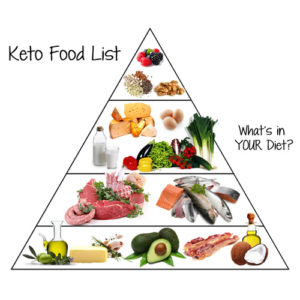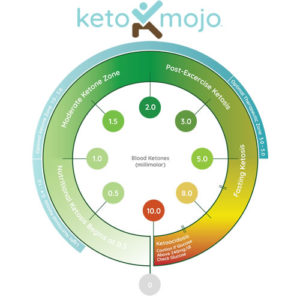It seems to me that everyone wants to know how to get into ketosis. So many people ask me “What is Ketosis?”. Ketosis is the best metabolic method for losing weight. Ketosis will provide lots of health benefits.
When you are not in ketosis your body converts carbohydrates (carbs) into glucose. This is the energy source used by most of society. However, when in ketosis, your digestive system changes fat into ketones. Your body then uses those as a main energy source.
I quote a few Scientific studies I have discovered in this article. One of them found that diets which promote ketosis commonly stimulate weight loss. This is partly due to their appetite-suppressing effects.
Newer research I have heard about shows a possibility that ketosis may also be helpful for type 2 diabetes and common neurological disorders. Even disorders such as Autism, ASD, ADHD and ODD.
However, getting into ketosis will take some work and planning. It’s not just as easy as not eating carbs.

I love explaining my ketogenic transformation! I dropped 28 KG over 3 months in 2018. I did this using pure ketosis, no gym or cardio – just diet. My dad always told me that Abs are made in the kitchen.
In my before and after photo I dont show my whole body. However, you can see the change of shape in my face alone!
I had no idea Ketone Supplements existed when I started. I used the FAT FAST method. This method gave me minor stomach pains and urgent bathroom trips if you get what I mean…
Now I found exogenous ketones. Skip the Science below and go learn about my shortcut!
 Eating a low-carb or zero-carb diet is by far the most important factor in how to get into ketosis.
Eating a low-carb or zero-carb diet is by far the most important factor in how to get into ketosis.
I learnt that usually, your bodies cells use glucose, or sugar, as their main source of fuel. This source of fuel burns out fast though. Fortunately, most of your cells can also use other more efficient fuel sources. These fuel sources include fatty acids, as well as ketones, which are also known as ketone bodies.
Your body stores glucose in your liver and muscles in the form of glycogen.
When you don’t eat many carbs, glycogen stores are reduced and levels of insulin decline. This sends a signal for fatty acids to be released from fat stores all over your body.
Your liver changes some of these fatty acids into the ketone bodies. These Ketone bodies are acetone, acetoacetate and beta-hydroxybutyrate. These 3 ketones can be used as fuel by portions of the brain.
Each person’s level of carb restriction needed to get you into ketosis is somewhat different. Many people limit net carbs (total carbs minus fiber) to 20 grams or less per day, while others can achieve ketosis while eating twice this amount or even more.
For this reason, the Atkins diet, a book published in the early 1970’s. It specifies that carbs should be restricted to less than 20 grams per day. Restricted for two weeks to guarantee true ketosis is achieved.
After this point, if you want to, a small amount of carbs may be added back to your diet. Do it very gradually, as long as you are still in ketosis.
In a one-week study of a controlled group of overweight people with type 2 diabetes. The study limited carb intake to 21 or fewer grams per day. The subjects experienced daily urinary ketone excretion levels higher than 27 times their baseline levels.
In another study, adults with type 2 diabetes were allowed 20–50 grams of digestible carbs per day, depending on the number of grams that allowed them to maintain blood ketone levels within a target range of 0.5–3.0 mmol/L.
These carb and ketone ranges are advised for people who want to get into ketosis. Ketosis for the purpose of weight loss, controlling blood sugar levels or reducing their heart disease risk factors.
Also, therapeutic ketogenic diets have been used for epilepsy or even as an experimental cancer therapy. They often restricted carbs to fewer than 5% of overall calories or fewer than 15 grams per day to drive up ketone levels.
However, anyone using the diet for therapeutic purposes should always do so under the supervision of a medical professional.
THE BOTTOM LINE:
Limiting your carb intake to 20–50 net grams per day lowers blood sugar and insulin levels. This will lead to the release of stored fatty acids that your liver converts into ketones.
 Eating or drinking coconut oil will help you get into ketosis.
Eating or drinking coconut oil will help you get into ketosis.
Coconut Oil contains fats called medium-chain triglycerides (MCTs).
Unlike most fats, MCTs are rapidly absorbed and taken directly to the liver. In the liver they can be used straight away as energy or converted into ketones.
In fact, it’s been suggested that eating or drinking coconut oil is the best way to increase your ketone levels. This has even been know to work in people with Alzheimer’s disease and other nervous system disorders.
Coconut oil contains four types of MCTs. And 50% of its fat comes from the kind known as lauric acid.
Research suggests that fat sources with higher lauric acid produces a more stable long term level of ketosis. The reason for this is because it’s metabolised more slowly than other MCTs.
MCTs are often used to induce ketosis in epileptic children. This is done without restricting carb intake as drastically as the classic ketogenic diet.
Several studies have been conducted on a high-MCT diets. They concluded that diets containing around 20% of the calories from carbs produces effects similar to the classic ketogenic diet. This allows less than 5% of calories from carbs.
However, when adding coconut oil into your diet, it’s smart to do so slowly. Slowly in order to minimise the digestive side effects such as stomach cramping and even explosive diarrhoea.
If you want to know how to get into ketosis comfortably, start with one teaspoon per day and work toward two or three tablespoons every over the course of a week.
BOTTOM LINE:
Eating or drinking coconut oil really does provide your body with MCTs. These MCTs are quickly absorbed and converted into ketone bodies by your liver.
 A heap of studies have shown that being in a state of ketosis may be beneficial for a few types of athletic performance, especially endurance exercises.
A heap of studies have shown that being in a state of ketosis may be beneficial for a few types of athletic performance, especially endurance exercises.
And being more active can also help you get into ketosis.
When you exercise, you run your body short of glycogen stores. Usually, these are replaced when you eat carbs. Which are then broken down into glucose which is converted to glycogen.
However, if your carb intake is minimised, the glycogen stores remain low. As a result, your liver increases the production of ketones. These ketones can be used as an alternate fuel source for your muscles. A fuel source which is much more efficient.
A recent study discovered that at low blood ketone concentrations, exercise increased the rate of ketone production. However, when blood ketones levels are already high, they don’t increase with exercise and may actually decrease for a short period.
One thing is for sure, working out in a fasted state has been proven to elevate ketone levels.
In a smaller study, nine older women exercised before or after eating. Their blood ketone levels were 135–315% higher when they exercised before a meal than when they exercised after a meal.
Remember that although exercise increases ketone production. It may take from one to four weeks for your body to get used to using ketones and fatty acids as its main source of fuel. During this time, your physical performance will probably be reduced for a little bit of time.
BOTTOM LINE
Working out using cardio or lifting weights can increase ketone levels during a carb restriction. This effect will be enhanced by working out in a state of fasting.
 Eating lots of healthy fats will usually boost your ketone levels and help you reach ketosis faster.
Eating lots of healthy fats will usually boost your ketone levels and help you reach ketosis faster.
A very low-carb ketogenic diet not only means minimizing carbs, but is also increasing fats.
Ketogenic diets focused on weight loss. Also with metabolic health and exercise performance will usually provide between 60–80% of calories from fats alone.
The classic ketogenic diet used in the treatment of epilepsy is even higher again in fat. With typically 85–90% of calories sourced from fats.
Remember this fact, extremely high fat intake doesn’t necessarily always translate into higher ketone levels.
A different three-week study of 11 healthy people was completed. It compared the effects of fasting with different levels of fat on breath ketone levels. This wouldn’t have been a fun study as ketone breath is described as one of the worst smells.
Ketone levels were similar in people getting 79% – 90% of their calories from fats.
Also, because fats make up such a high percentage of any version of the ketogenic diet, it’s important to choose high-quality fats.
Good fats include olive oil, avocado oil, coconut oil, butter, lard and tallow. And there are many healthy, high-fat foods that are also very low in carbs.
Remember this, if your goal is dropping weight, it’s very important not to be consuming too many calories in total. As this can cause your weight loss to slow down – even in ketosis.
BOTTOM LINE:
Eating at least 60% of your calories from fats will help boost your ketone levels. Choose a variety of high quality fats from both plant and or animal sources.
 .jpg” alt=”” width=”500″ height=”500″ />Another method of how to get into ketosis is to go without eating for several hours.
.jpg” alt=”” width=”500″ height=”500″ />Another method of how to get into ketosis is to go without eating for several hours.
Many people go into mild ketosis between dinner and breakfast without even knowing it!
Children with epilepsy are sometimes stopped from eating for 24–48 hours before they start their ketogenic diet. This is done to get into ketosis faster in order to reduce seizures sooner.
Intermittent fasting, a newer dietary approach which involves regular short-term fasts, can also induce ketosis.
Also, “fat fasting” is another ketone-boosting method which mimics the effects of fasting.
Fat Fasting involves eating around 1,000 calories daily, 85–90% of these calories come from fats. This mixture of low calorie and very high fat intake can often help you achieve ketosis in a shorter period of time.
A study in 1965 showed a significant fat loss in overweight patients who did a fat fast. However, other researchers have pointed out that these results appear to have been grossly exaggerated.
Because a fat fast is usually very low in protein and calories, it should only be followed for a maximum of three to five days so as to prevent an excessive loss of muscle mass. Either way its not easy to stick to for more than a couple of days.
Here are some tips and ideas for how to get into ketosis fast.
BOTTOM LINE:
Using Fasting, intermittent fasting and a “fat fast” can all help you get into ketosis in a relatively quick manner.
 Reaching ketosis requires a protein intake level which is adequate but not too excessive.
Reaching ketosis requires a protein intake level which is adequate but not too excessive.
The classic ketogenic diet used in most epileptic patients is restricted in both carbs and protein to maximize ketones.
The same diet may also be beneficial for cancer patients, as it has been known to limit tumor growth.
For most people, cutting back on protein to increase ketone production isn’t a very healthy practice.
Remember, it’s very important to consume enough protein to supply your liver with amino acids. Amino acids that can be used for gluconeogenesis, which translates to “making new glucose.”
In this process, your liver creates glucose for the few cells and organs in your body that can’t live without glucose or use ketones as fuel. Organs such as your red blood cells and portions of your kidneys and even your brain.
Secondly, protein intake needs to be high enough to maintain your current muscle mass when your carb intake is low, especially during weight loss.
Even though losing weight typically results in the loss of muscle as well as fat, eating enough protein on a very low-carb ketogenic diet can help preserve your current muscle mass.
Multiple studies have shown that the preservation of muscle mass and physical performance is heightened when protein intake is around 0.55–0.77 grams per pound (1.2–1.7 grams per kilogram) of lean mass.
In recent weight loss studies, very low-carb diets with a protein consumption within this range have been found to bring on and even keep ketosis going.
In another study of 17 obese men, after a ketogenic diet providing 30% of needed calories from protein for four weeks led to average blood ketone levels of 1.52 mmol/L. This was well within the 0.5–3.0 mmol/L range of nutritional ketosis.
If you want to calculate your protein needs on a ketogenic diet, multiply your ideal body weight in pounds by 0.55 to 0.77 (1.2 to 1.7 in kilograms). So if your ideal body weight is 130 pounds (59 kg), you need to eat 71–100 grams of protein.
BOTTOM LINE
Eating too little protein will cause muscle mass loss, whereas to much protein may slow or even stop ketone production.
 Like lots of things in nutrition, getting into and keeping in ketosis is highly individualized.
Like lots of things in nutrition, getting into and keeping in ketosis is highly individualized.
Therefore, it is helpful to test your ketone levels regularly to ensure you’re achieving your goals.
The three types of ketones — acetone, beta-hydroxybutyrate and acetoacetate — can all be measured in your breath, blood or even urine.
Acetone is commonly found on your breath. Studies have shown that testing acetone breath levels is a reliable way to watch the level of ketosis in people following ketogenic diets.
The Ketonix meter measures acetone in breath. After breathing into the meter, a color flashes to indicate whether you are in ketosis and how high your levels are.
Ketones can also be measured with a blood ketone meter. This is achieved in a similar way to that a glucose meter works, a small drop of blood is placed on a strip which is inserted into the meter.
The meter measures the amount of beta-hydroxybutyrate in your blood, and it has a great accuracy in the levels of your ketosis.
There is one disadvantage of measuring blood ketones, it’s that the strips are very expensive.
Finally, the ketone measured in your urine is called acetoacetate. Ketone urine strips are dipped into your urine and they turn various shades of pink or purple depending on your level of present ketones. The darker the color the higher ketone levels are being reflected.
Ketone urine strips are simple to use and fairly cheap. Their accuracy in long-term use has been questioned, they should only be used to initially provide confirmation that you are in ketosis.
Recent studies found that urinary ketones are usually highest in early morning times and after an evening meal when on a ketogenic diet.
Using multiple methods to test your ketones will help you know if you need to make changes to your diet to get into ketosis.
Copyright © 2019 | How to get in to Ketosis | Website By Sites By Design – Managed SEO